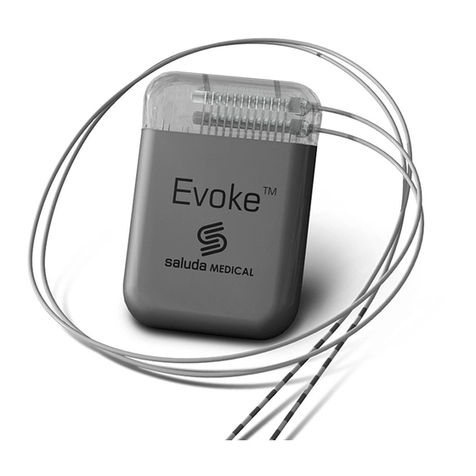
Document Reference: CLIN-UMAN-002426 Revision: 13.00 Page 7 of 48
oIf an MRI scan is suggested for you, it is extremely important that you inform
the clinician recommending the MRI scan that you have an implanted SCS
system, along with the clinical staff who will perform the MRI scan.
oIt is also extremely important that you tell your doctor who looks after you in
relation to your stimulator, if an MRI scan is suggested for you.
oUnder specific conditions, you may be able to have an MRI scan of your head
or knee, but under no circumstances should you have an MRI scan of your
trunk/full body.
oAll external components of the Evoke System (e.g. Evoke Pocket Console,
Evoke Charger and magnet) are MR Unsafe and must be removed before
entering a room where an MRI scanner is located.
•MRI scans that are not performed according to the Evoke SCS System MRI Guidelines
may:
oCause significant heating resulting in tissue damage, severe injury, or death.
oDamage the CLS and you may need surgery to replace it.
oCause unintended stimulation such as tingling, shocking or jolting.
Specific information for doctors and radiological staff detailing the safe conditions for
MRI scanning with the Evoke System can be found in the Evoke SCS System MRI
Guidelines, accessible at http://www.saludamedical.com/manuals.
CT Scans
•Patients implanted with the Evoke System may experience a momentary increase in
stimulation when receiving a CT scan. Some patients have described this as
uncomfortable stimulation, jolting or a shocking sensation.
•You should turn your stimulator off before undergoing a CT scan.
Implanted cardiac pacemakers or defibrillators may be affected by your Evoke System
•You should not use your Evoke System if you have any implanted cardiac devices,
due to interference between them.
•The effect of other implanted stimulators on your Evoke System is unknown. We
recommend that you should consult your doctor before undergoing implantation of
other medical devices.
Strong electromagnetic fields may cause you discomfort
•Avoid strong electromagnetic fields as they may cause your stimulator to switch off,
cause an uncomfortable or jolting sensation, or affect communication with your EPC.
•Your stimulator may be affected by:
oSecurity screeners such as those used at department stores, public buildings,
and airports – present your Patient ID Card and request to go around the
screener.
Turn stimulation off if you are required to go through the scanner.
































